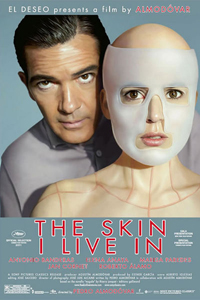It is stunning the lengths that director Pedro Almodóvar will go to in order to explore a concept or make a point. His new film The Skin I Live In is at times compelling, at times utterly ludicrous, but there is always something eye-catching or stomach-churning to watch.
 Almodóvar returns to familiar territory. An exploration of gender and how it defines us, both as individuals and within our social context, is at the heart of The Skin I Live In. The struggle for power and dominance consumes the interactions between men and women, and the line between the sexes becomes increasingly fuzzy as the film progresses.
Almodóvar returns to familiar territory. An exploration of gender and how it defines us, both as individuals and within our social context, is at the heart of The Skin I Live In. The struggle for power and dominance consumes the interactions between men and women, and the line between the sexes becomes increasingly fuzzy as the film progresses.
Robert (Antonio Banderas), a brilliant plastic surgeon, is holding captive a young woman, Vera (Elena Anaya), at his palatial estate. His home comes equipped with a state of the art surgery center and research lab. The nature of their relationship is unclear, but we can see that Vera is part captive, part creation – a work of art for the artist, Robert, to gaze upon in secrecy through closed circuit television feeds.
Human sexual interactions are a struggle not to procreate and carry on the species, but an interaction between predator and prey. Almodóvar is not shy about making this particular point utterly apparent.
 During the months of Carnival, Zeca (Roberto Álamo), a local criminal and Robert’s brother, dressed head to toe as a tiger, drops in on Robert’s compound. When he sees the young Vera, trapped in her room, he must have her. He chases her, dives, claws, and pounces like a cat. He even licks at her face as he forces himself upon her gazelle like frame.
During the months of Carnival, Zeca (Roberto Álamo), a local criminal and Robert’s brother, dressed head to toe as a tiger, drops in on Robert’s compound. When he sees the young Vera, trapped in her room, he must have her. He chases her, dives, claws, and pounces like a cat. He even licks at her face as he forces himself upon her gazelle like frame.
If that were not enough, we later see Vera watching a nature documentary in which a cheetah runs down and kills a young antelope. The characters in The Skin I Live In are drawn to sex as a desire to kill and feed. Be warned, Almodovar is not afraid to present images of rape and other forms of emotional and physical abuse with disturbing clarity.
 There is lushness and mastery to Almodovar’s visuals. Rich colors and repetition of motifs and framing devices fill this cinematic landscape. Whether we are in the stark sterility of the operating room or sitting around the warmth of a campfire after some traumatic event, the image is always textured and multi-layered.
There is lushness and mastery to Almodovar’s visuals. Rich colors and repetition of motifs and framing devices fill this cinematic landscape. Whether we are in the stark sterility of the operating room or sitting around the warmth of a campfire after some traumatic event, the image is always textured and multi-layered.
I felt that, though Almodóvar’s concept is intriguing and he offers many visuals to mull over, The Skin I Live In feels more like an overly didactic exploration than a cohesive film. This is not the dreamy sumptuous spiritual exploration of The Tree of Life. Instead Almodóvar’s film feels more like an argument with someone that has already made up their mind.
I can’t decide whether The Skin I Live had too many loose ends or too few, but either way, I was largely unsatisfied by the film.







{ 3 comments }
love u trey, but i disagree – for i, was pretty much completely satisfied by the film loved it. Maybe it a gay thang 😉
I did try to be fair to Pedro, since it may be more my personal preference. Glad you still loves me, though. I’d be interested to hear your take on ‘TSILI.’
Good review, Trey. I am pretty much where you are. It’s without question an interesting and provoking film. And certain haunting aspects are staying with me, but none of the characters develop (aside from the, ahem, obvious). I’m not even sure what the point is. If it is that crazy people are gonna be crazy, then that’s fine, but there was too much missing to make it work.
All that said, Elena Anaya is a stunning beauty. (Making the haunting stuff all the more haunting.)
Comments on this entry are closed.